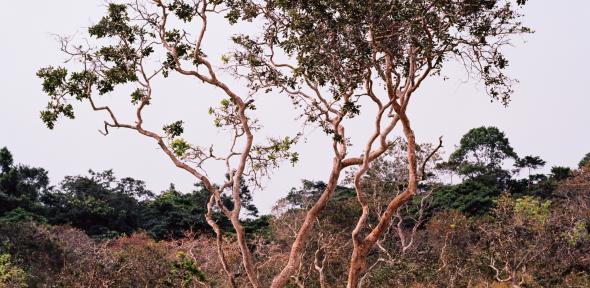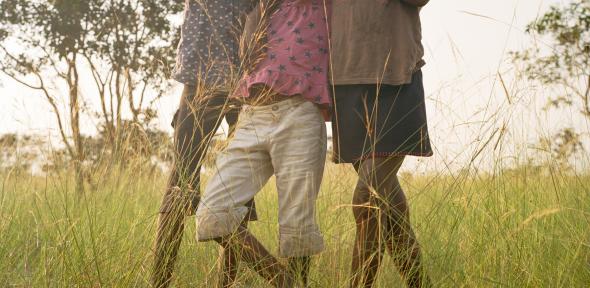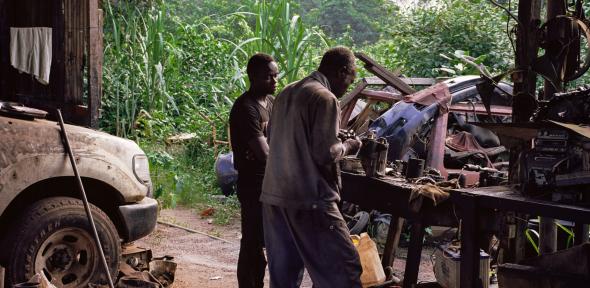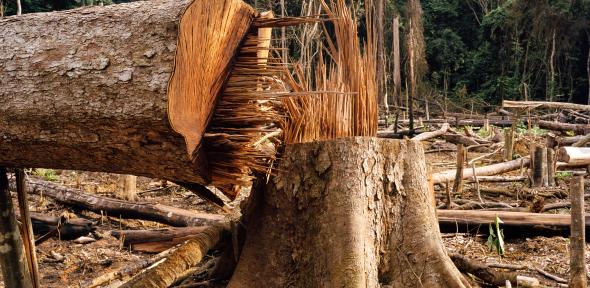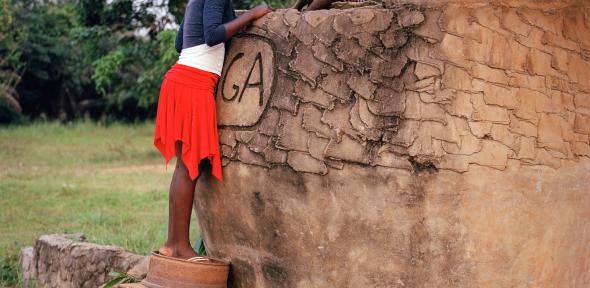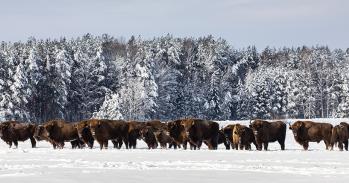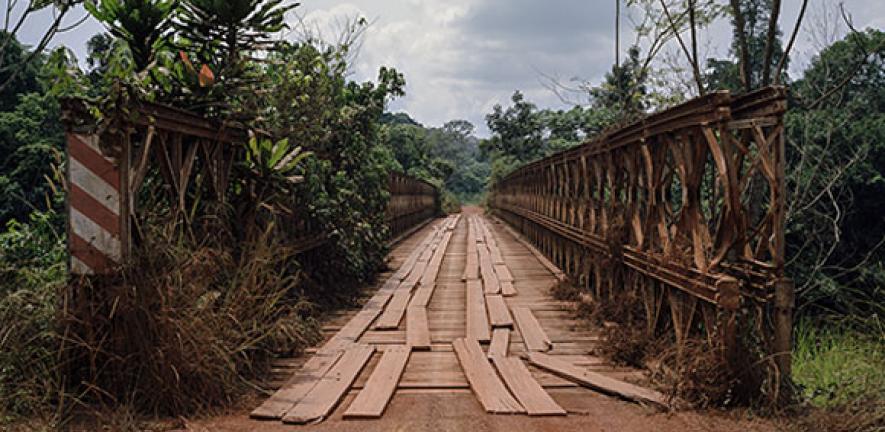
Disco Tony has travelled over 5,000 miles. He is grey with a yellow ring around his eyes. He is a cuckoo, but not just any cuckoo. He is one of a very special group of birds whose every move is being monitored.
Disco Tony has travelled over 5,000 miles. He is grey with a yellow ring around his eyes. He is a cuckoo, but not just any cuckoo. He is one of a very special group of birds whose every move is being monitored.
Toby’s work will contribute towards a common understanding between ornithological researchers and development researchers about the way people and birds share landscapes
Bill Adams
Earlier this year, Toby Smith followed the moves of Disco Tony and his fellow cuckoos – a journey that took him to the forests of Gabon in West Africa and the fringes of the Batéké Plateau grasslands.
As a photojournalist – and first Leverhulme artist-in-residence at the University of Cambridge Conservation Research Institute (UCCRI) – his aim was both to photograph the landscape and to talk to the local villagers and hunters with whom the cuckoos share their home.
The result is a remarkable series of images that is providing bird researchers with a comprehensive idea of the rural landscapes in which the cuckoos overwinter.
The cuckoos all carry tiny lightweight devices that transmit a satellite-trackable signal as they make their arduous journey from breeding grounds in the UK south to Africa. Over the past five years, the signals of around 50 cuckoos have been helping a team of researchers at the British Trust for Ornithology (BTO) gain the first information on what happens to Africa-bound migrant birds after they have left the shores of the UK. The BTO’s hope is that this will help solve the mystery of why the cuckoo population has halved in the UK in the past 20 years.
Dr Chris Hewson, who leads the BTO project, explains: “Before we started the work, all we knew was that we were seeing a continual drop in cuckoo numbers. We didn’t know whether this was a result of changes in the UK breeding grounds, or of fatalities on the migration routes or in Africa. But, by tracking the birds, we now know which routes they take and the relative costs of each in terms of mortality, which has led us to begin to understand some of the causes of the decline.”
In fact the cuckoo is not alone in facing an uncertain future, says Juliet Vickery at the RSPB’s Centre for Conservation Science: “Around 70% of long-distant migrant bird species that winter in sub-Saharan Africa are declining. For most we don’t understand why, but the causes are likely to be complex as they face loss of habitat, through human- and drought-related land use change, hunting and climate change, right across the flyway.”
“We expect birds like cuckoos, swallows, swifts and nightingales to rock up here every summer but what if they don’t arrive?” adds Professor Bill Adams from the Department of Geography. Four years ago, he teamed up with Vickery, Hewson and researchers at the Department of Zoology to review all of the information available on the fate of the birds in a project funded by the Cambridge Conservation Initiative.
It became clear that really very little was known. In particular, there were few comparative studies on the effects of land use change in regions in Africa frequented by many of the 2.1 billion birds that migrate from Europe during the non-breeding season.
“These regions are areas where poverty makes the welfare of urban and rural people the policy priority,” adds Adams. “Often what is good news for people – adapting land to create work and food – is bad news for birds unless there is a sophisticated understanding of the implications of habitat requirements. Only then can we hope that decision making can support nature too.”
Adams and others view Africa as a major gap in knowledge about land use and birds: “In Europe we know a lot about how and why people use rural land, and what this means for migrant birds. But we don’t know much about rural African landscapes in which birds spend the winter.”
However, a few months ago, an idea began to take shape that could provide a step towards bridging this knowledge gap.
Smith had just taken up his role as artist-in-residence at UCCRI. Speaking to Adams and Hewson about the fate of the cuckoos, he was fascinated: “I wondered whether I could follow the cuckoos to Africa. No-one really knows what the cuckoo finds there – how people fashion a landscape that’s either friendly or unfriendly for cuckoos. I wanted to contribute to the research project by providing ‘eyes on the ground’ at their journey’s end.”
“The most important element in land use change in this region is the rural household,” explains Adams. “And the opportunity to present the landscapes in photographs that help us understand woodland management and agricultural practice was very attractive.”
Actually spotting a cuckoo, however, was unlikely, as Smith explains: “The tracking data is accurate enough to pinpoint where the cuckoos are to within 500 m, but there’s a delay between the signal being transmitted by the bird’s tag and being accessible to us in the field, and the forest terrain is vast.
“Seeing a bird would have been epic but, from a visual perspective, it wouldn’t have told us anything new. I wasn’t there as a birdwatcher, I was there as a documentary photographer. I was more interested in experiencing and engaging with the natural and social landscape of these birds. Very little scientific attention had been paid to this area – even Gabon’s most prolific birder hadn’t been there in 35 years.”
And so in January 2016, Toby Smith and Malcolm Green, an oral storyteller, arrived in Gabon with hammocks and a petrol stove, hired an off-road vehicle and set off to bush-camp for almost two weeks. Their trip was funded through Flight Lines (a joint project between the BTO and the Society of Wildlife Artists), the Economic and Social Research Council Impact Acceleration account, and Smith and Green themselves. They spoke to hunters and villagers, asking what they knew of the cuckoo – “we used photographs and bird-song recordings to help identify any interactions” – and Smith photographed the cuckoo’s habitat of forest margins and grasslands on the Batéké Plateau.
Back home, he opened up his photo editing and curating process to conservation specialists like Chris Hewson and other partners in the Cambridge Conservation Initiative – a unique collaboration between the University of Cambridge and biodiversity conservation organisations within the newly opened David Attenborough Building.
“Conservationists have a specific aesthetic interpretation of pictures, and so Chris and others needed to be really involved in the process of selecting which images told an important part of the cuckoo’s story.
“Generally, what I found in Gabon was encouraging. The density of people is so thin that even if the bird was hunted within 40 km of each village there are still huge areas available. It’s an area of great biodiversity and the villagers are not hugely aware of the cuckoo among the general flora and fauna.
“There was an incredible mosaic of gallery forest where the water table is accessible beneath the sand. And there were abrupt transitions between savannah landscape and forested landscape – there’s a lot of forest edge. From what we know about cuckoo behaviour this suits them to a T.”
“However, future land use change in the Gabon is likely to accelerate,” says Hewson. “To have Toby’s eye-witness account now is really important. Even finding that people rarely see cuckoos there is instructive for us – it shows what we are going to be up against when we go out there. It helps us to piece this together with knowledge of migration routes, to provide a more fully formed idea of what happens to the cuckoo for the major part of its annual cycle.”
Recently, the BTO tracking project has shown for the first time that cuckoos use two different routes to reach Africa (through Italy and across the Sahara, and through Spain and around the edge of West Africa) and that the Spanish route is associated with greater mortality. The team has found that the use of this route within local breeding populations correlates with population decline. In an article recently published in NatureCommunications, the researchers suggest that this might be linked to severe droughts in Spain, such as in 2012, and raise concerns that a more recent drought in Italy might have further repercussions for the declining cuckoo population.
“Ultimately more research is vital,” says Adams, who has a joint project with Vickery starting next year in Ghana to look at the drivers of land use change and the impact on birds. “My hope is that Toby’s work will contribute towards a common understanding between ornithological researchers and development researchers about the way people and birds share landscapes.”
Meanwhile, as of March 2016, and after no signal for seven weeks, Disco Tony “popped back up” according to the BTO’s blog of each of the cuckoo’s whereabouts. Traced to the Central African Republic, he has begun his long journey back to the bog in Wales.
Why the name Disco Tony? The Welsh bog in which he was tagged was a particularly challenging environment to work in, with high tussocky grass. To reach the captured cuckoo, bird-ringer Tony Cross had to do a hopping, balancing, disco dance of a run. Naming the cuckoo Disco Tony seemed only appropriate.
www.bto.org/science/migration/tracking-studies/cuckoo-tracking/disco_tony

The text in this work is licensed under a Creative Commons Attribution 4.0 International License. For image use please see separate credits above.




